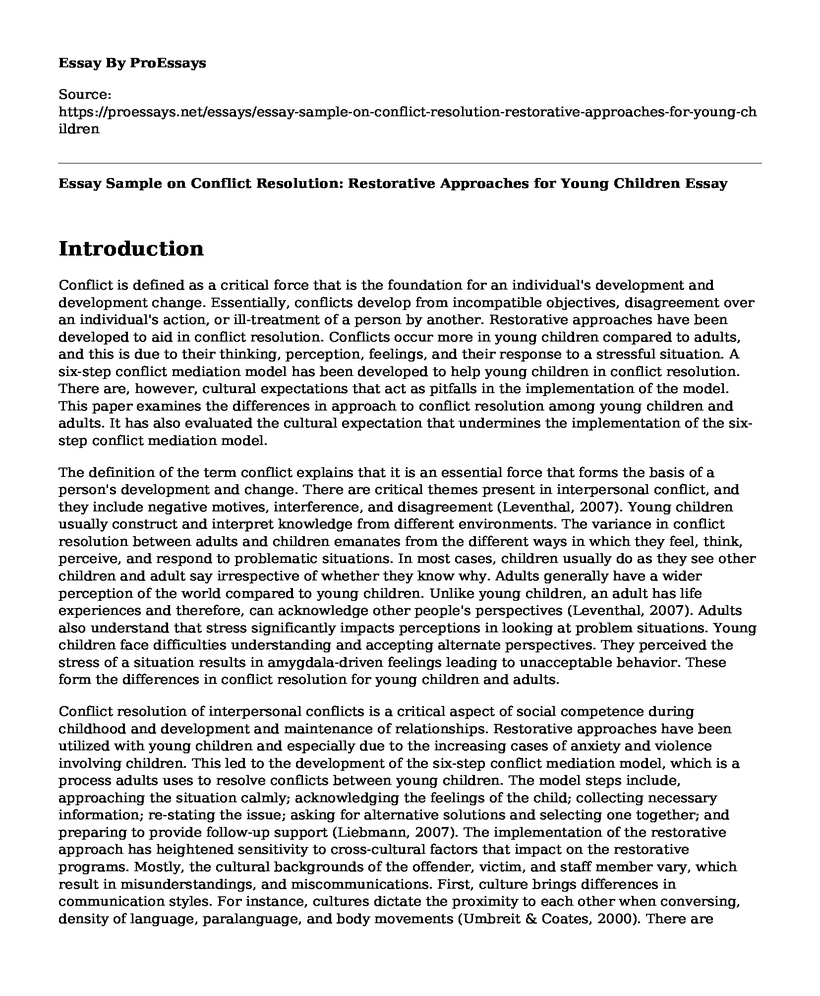Introduction
Conflict is defined as a critical force that is the foundation for an individual's development and development change. Essentially, conflicts develop from incompatible objectives, disagreement over an individual's action, or ill-treatment of a person by another. Restorative approaches have been developed to aid in conflict resolution. Conflicts occur more in young children compared to adults, and this is due to their thinking, perception, feelings, and their response to a stressful situation. A six-step conflict mediation model has been developed to help young children in conflict resolution. There are, however, cultural expectations that act as pitfalls in the implementation of the model. This paper examines the differences in approach to conflict resolution among young children and adults. It has also evaluated the cultural expectation that undermines the implementation of the six-step conflict mediation model.
The definition of the term conflict explains that it is an essential force that forms the basis of a person's development and change. There are critical themes present in interpersonal conflict, and they include negative motives, interference, and disagreement (Leventhal, 2007). Young children usually construct and interpret knowledge from different environments. The variance in conflict resolution between adults and children emanates from the different ways in which they feel, think, perceive, and respond to problematic situations. In most cases, children usually do as they see other children and adult say irrespective of whether they know why. Adults generally have a wider perception of the world compared to young children. Unlike young children, an adult has life experiences and therefore, can acknowledge other people's perspectives (Leventhal, 2007). Adults also understand that stress significantly impacts perceptions in looking at problem situations. Young children face difficulties understanding and accepting alternate perspectives. They perceived the stress of a situation results in amygdala-driven feelings leading to unacceptable behavior. These form the differences in conflict resolution for young children and adults.
Conflict resolution of interpersonal conflicts is a critical aspect of social competence during childhood and development and maintenance of relationships. Restorative approaches have been utilized with young children and especially due to the increasing cases of anxiety and violence involving children. This led to the development of the six-step conflict mediation model, which is a process adults uses to resolve conflicts between young children. The model steps include, approaching the situation calmly; acknowledging the feelings of the child; collecting necessary information; re-stating the issue; asking for alternative solutions and selecting one together; and preparing to provide follow-up support (Liebmann, 2007). The implementation of the restorative approach has heightened sensitivity to cross-cultural factors that impact on the restorative programs. Mostly, the cultural backgrounds of the offender, victim, and staff member vary, which result in misunderstandings, and miscommunications. First, culture brings differences in communication styles. For instance, cultures dictate the proximity to each other when conversing, density of language, paralanguage, and body movements (Umbreit & Coates, 2000). There are differences among cultures that prevent implementation process. For example, American culture tends to be individualistic and competitive while which might not be the case with the Asian culture. Also, there are differences within cultures which can affect the implementation of restorative approaches. It means there are is the existence of subcultures within cultures. For instance, some cultural aspects are shared by Whites (Umbreit & Coates, 2000). However, White from the poor, rural background may have varying mannerism, communication patterns, and values to those of White in San Francisco. It, therefore, means that culture is a factor to consider the implementation of the six-step conflict mediation model.
Conclusion
In conclusion, conflict and its resolution form a critical aspect of social competence for children. Children are more likely to be involved in conflicts than adults and their conflict resolution process is also different. The factors that underlie these differences are perceptions, way of thinking, and behavioral response to stressful circumstances. The six-step conflict mediation model is a restorative approach developed to help children in conflict resolution. However, there are cultural implications such as the difference in communications styles, and differences among and within cultures.
References
Leventhal, u. (2007). Conflict Resolution Strategies in Young Children: Do They Do What They Say? Retrieved 30 September 2019, from https://pdfs.semanticscholar.org/721b/70fb9dd46f17f2adb61562370d7d010a1a9d.pdf
Liebmann, M. (2007). Restorative Justice: How It Works. London: Jessica Kingsley Publishers.
Umbreit, M., & Coates, R. (2000). Multicultural Implications of Restorative Justice: Potential Pitfalls and Dangers. Retrieved 30 September 2019, from https://www.ncjrs.gov/ovc_archives/reports/restorative_justice/restorative_justice_ascii_pdf/ncj176348.pdf
Cite this page
Essay Sample on Conflict Resolution: Restorative Approaches for Young Children. (2023, Feb 23). Retrieved from https://proessays.net/essays/essay-sample-on-conflict-resolution-restorative-approaches-for-young-children
If you are the original author of this essay and no longer wish to have it published on the ProEssays website, please click below to request its removal:
- Paper Example on Professional Skills
- Adult-Gerontology Primary Care Nurse Goals Paper Example
- Essay Example on Corporate Social Responsibility: Contending Definitions and Bias Claims
- Essay Example on Mitsubishi Polyester Firm: Proposed CSR Initiative
- Flexible Working: Benefits, Limitations & Opportunities - Essay Sample
- DNP-Prepared Nurses: Unlocking Interprofessional Collaboration - Essay Sample
- Law Enforcement Career - Free Paper Sample







